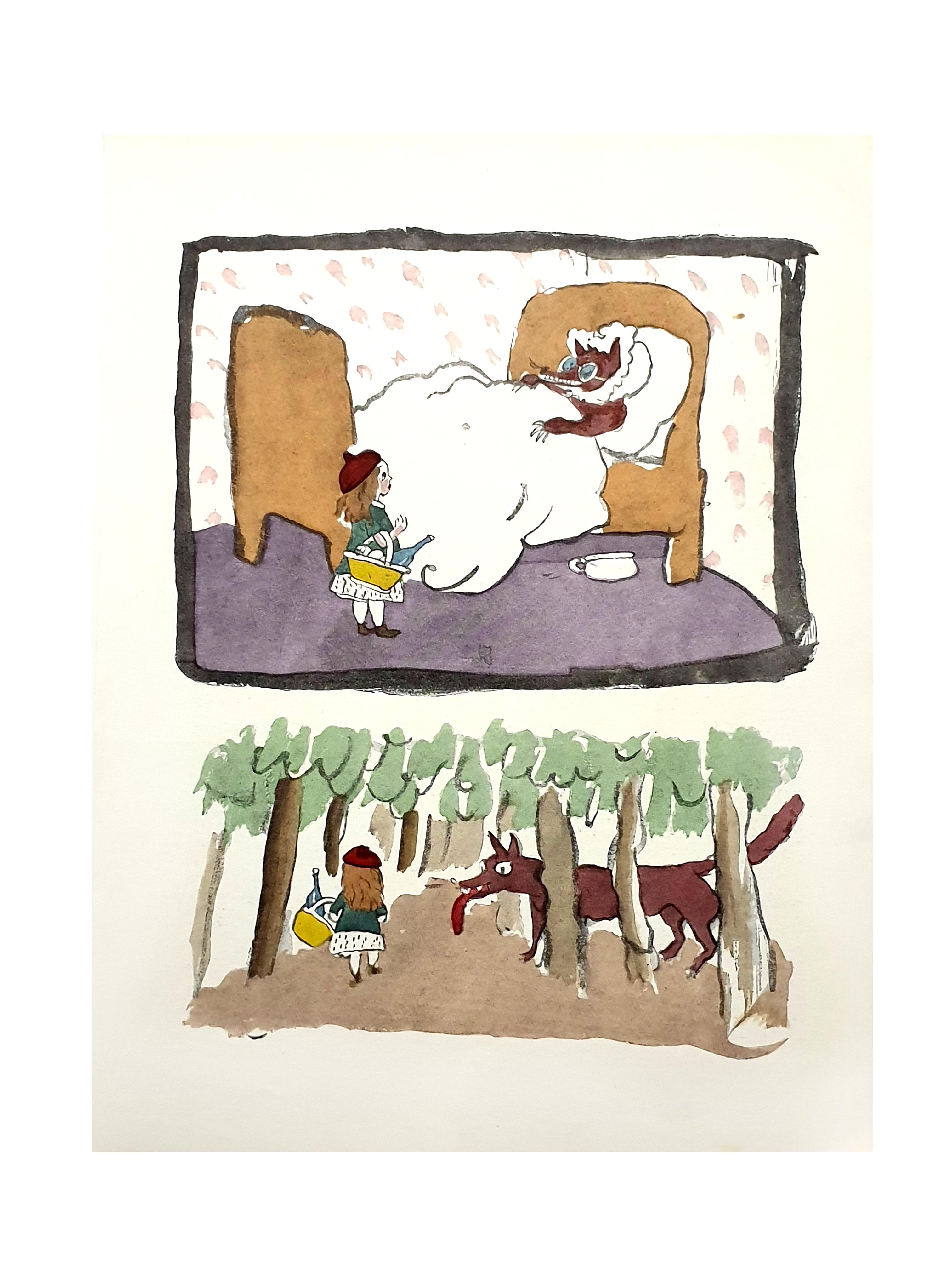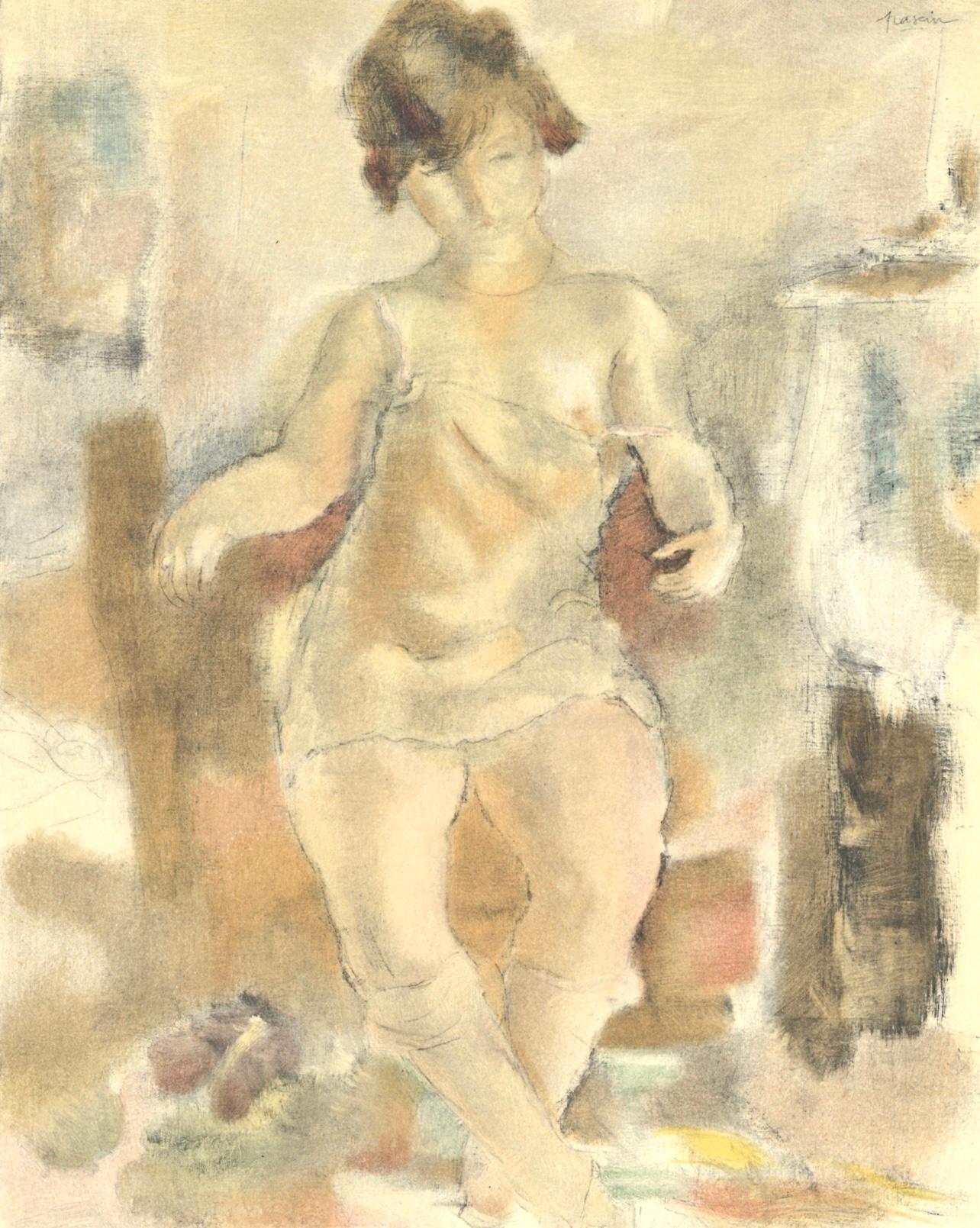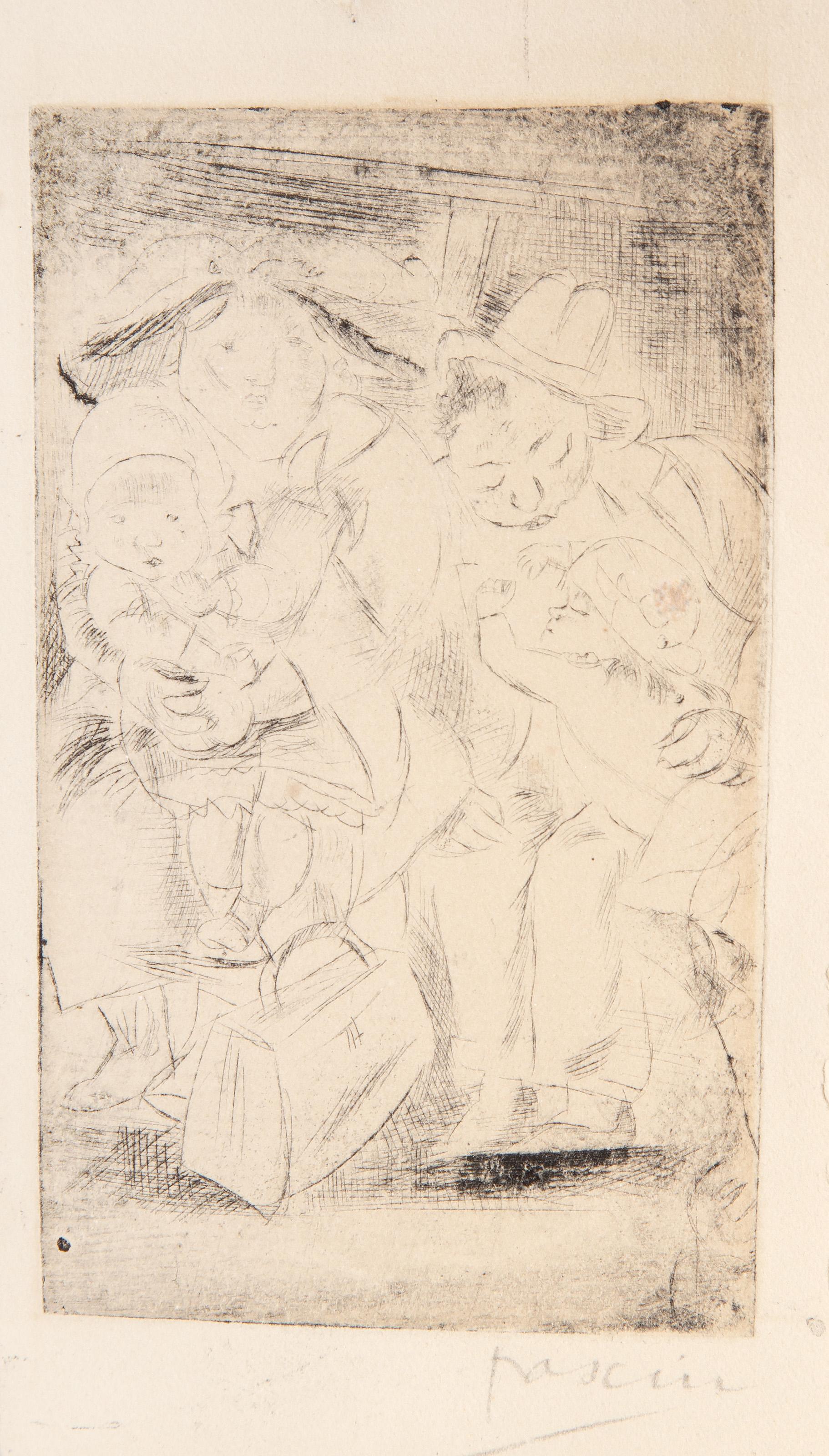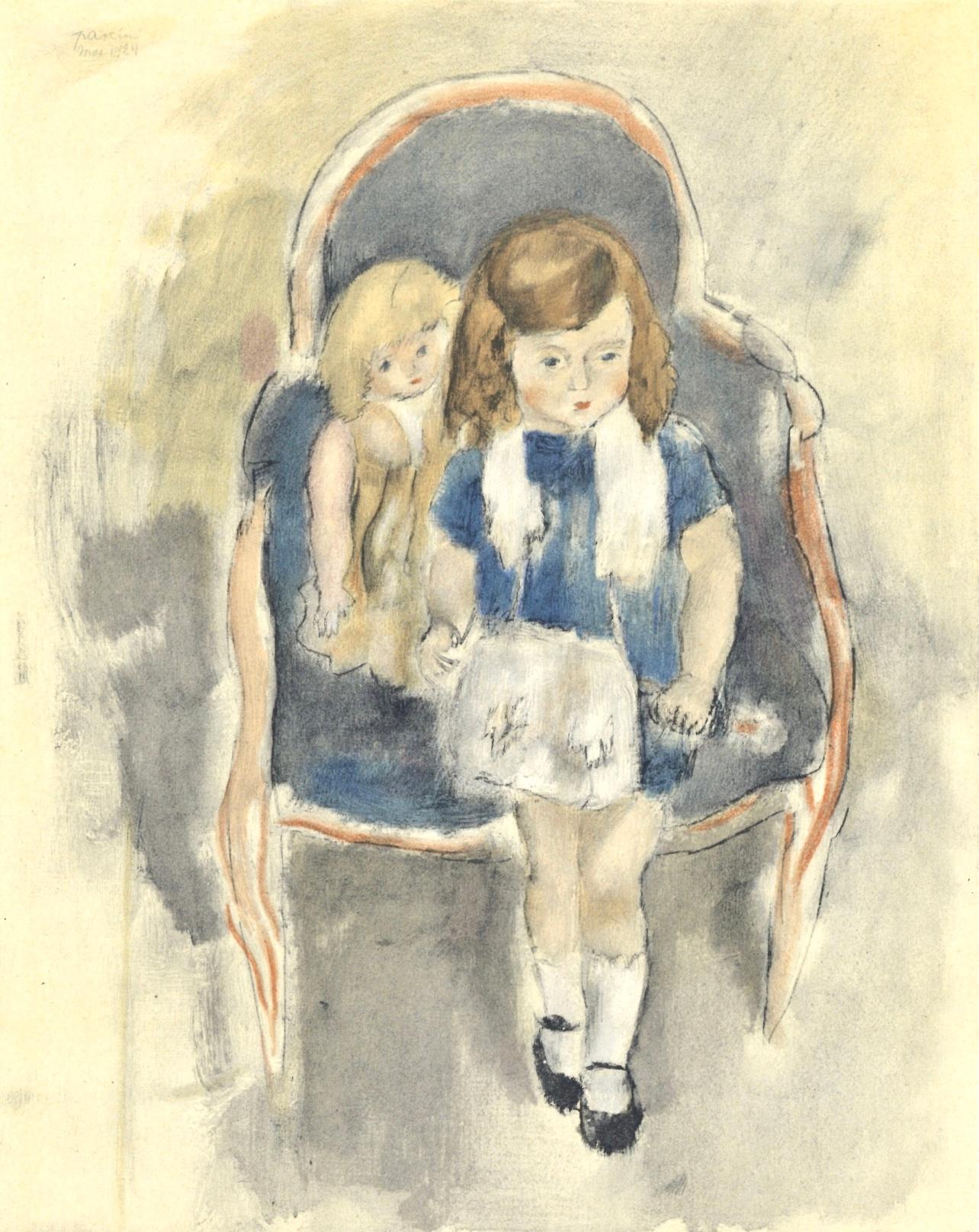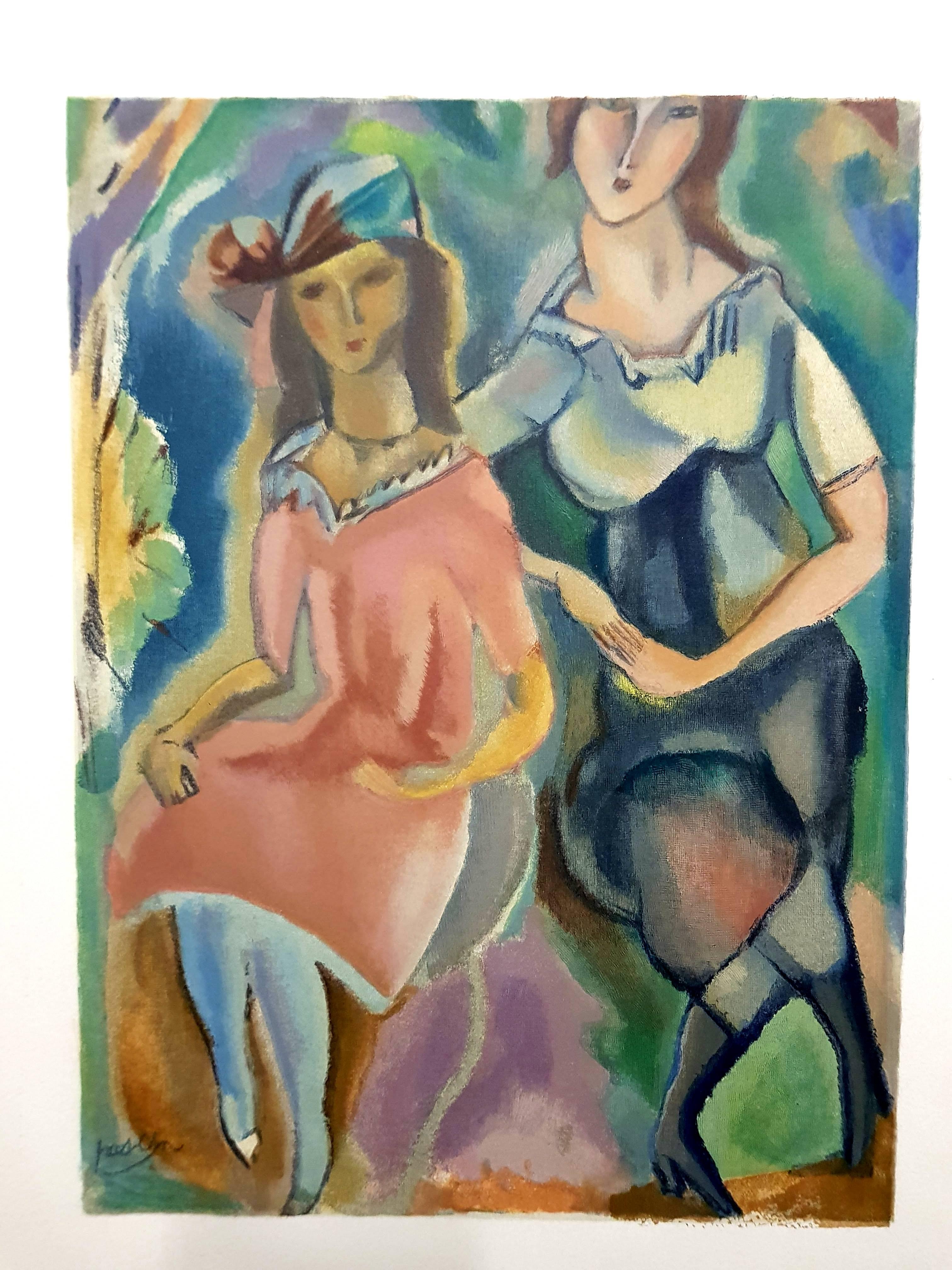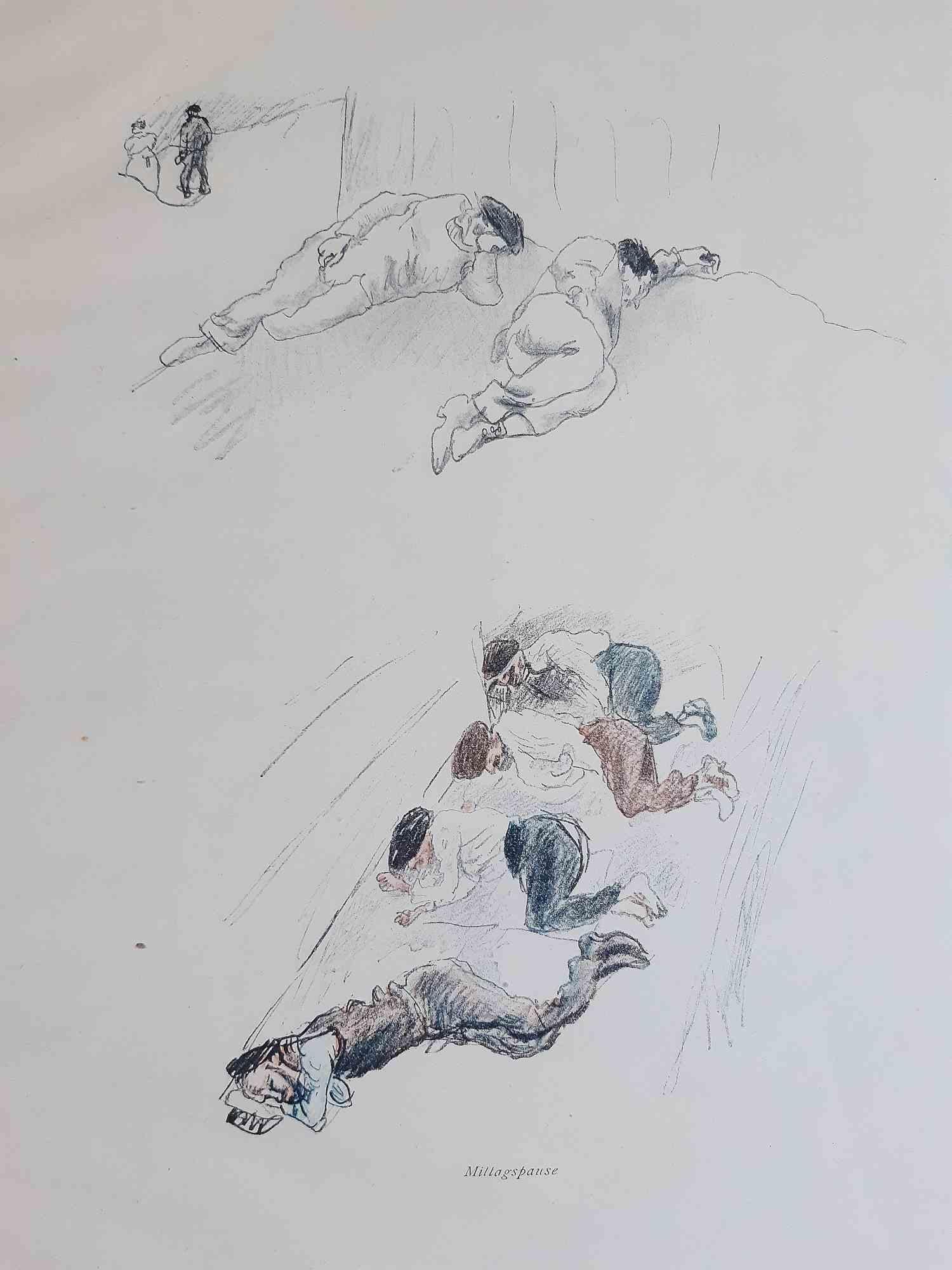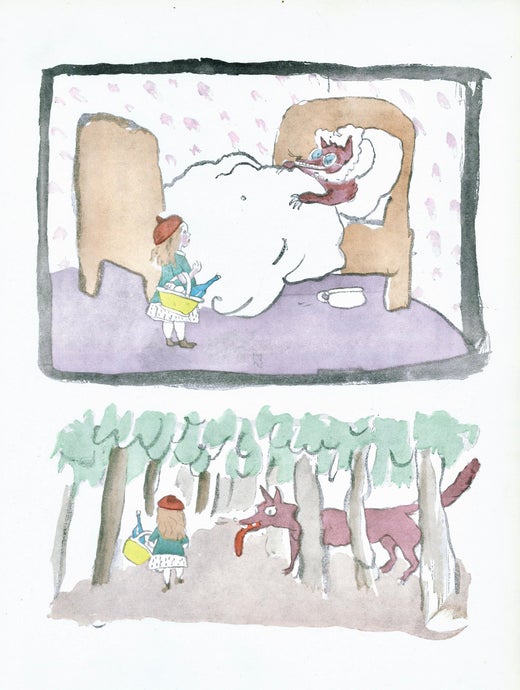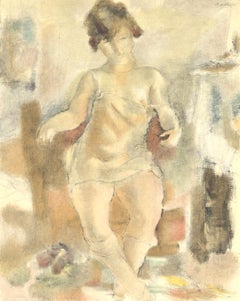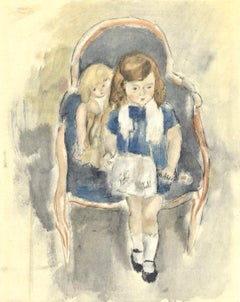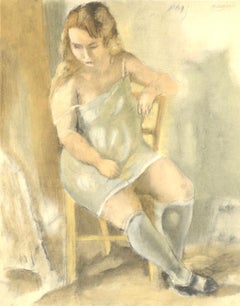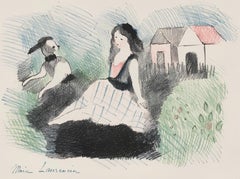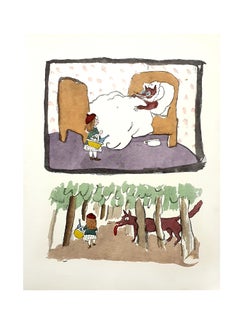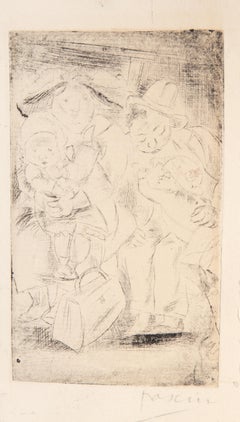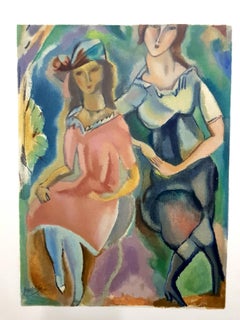Items Similar to Jules Pascin, Little Red Riding Hood, from XXe siecle, 1938 (after)
Want more images or videos?
Request additional images or videos from the seller
1 of 6
Jules PascinJules Pascin, Little Red Riding Hood, from XXe siecle, 1938 (after)1938
1938
$716
$89520% Off
£541.47
£676.8320% Off
€620.22
€775.2720% Off
CA$1,003.29
CA$1,254.1120% Off
A$1,095.25
A$1,369.0720% Off
CHF 576.66
CHF 720.8320% Off
MX$13,119.86
MX$16,399.8220% Off
NOK 7,375.32
NOK 9,219.1620% Off
SEK 6,733.79
SEK 8,417.2420% Off
DKK 4,633.19
DKK 5,791.4820% Off
About the Item
This exquisite lithograph after Jules Pascin (1885–1930), titled Le Petit Chaperon Rouge (Little Red Riding Hood), from the album XXe siecle, Sommaire du No. 1, 1er Mars 1938, Chroniques du jour, 13, Rue Valette, Paris (5e), Directeur: G. di San Lazzaro, originates from the 1938 edition published by Gualtieri di San Lazzaro, editeur, Paris, in collaboration with Societe Internationale d'Art XXe siecle, Paris, and printed by Mourlot Freres, Paris. Le Petit Chaperon Rouge exemplifies Pascin’s poetic mastery of line and form, blending sensitivity, intimacy, and emotional nuance in a composition that captures both the sensuality and melancholy of modern life.
Executed as a lithograph on velin paper, this work measures 12.5 × 9.75 inches (31.75 × 24.77 cm). Unsigned and unnumbered, as issued. The edition exemplifies the superb craftsmanship of Mourlot Freres, Paris.
Artwork Details:
Artist: After Jules Pascin (1885–1930)
Title: Le Petit Chaperon Rouge (Little Red Riding Hood), from the album XXe siecle, Sommaire du No. 1, 1er Mars 1938, Chroniques du jour, 13, Rue Valette, Paris (5e), Directeur: G. di San Lazzaro
Medium: Lithograph on velin paper
Dimensions: 12.5 × 9.75 inches (31.75 × 24.77 cm)
Inscription: Unsigned and unnumbered, as issued
Date: 1938
Publisher: Gualtieri di San Lazzaro, editeur, Paris, in collaboration with Societe Internationale d'Art XXe siecle, Paris
Printer: Mourlot Freres, Paris
Condition: Well preserved, consistent with age and medium
Provenance: From the album XXe siecle, Sommaire du No. 1, 1er Mars 1938, Chroniques du jour, 13, Rue Valette, Paris (5e), Directeur: G. di San Lazzaro, published by Gualtieri di San Lazzaro, editeur, Paris
About the Publication:
Gualtieri di San Lazzaro's XXe Siecle (Twentieth Century) was one of the most influential art journals of the modern era, founded in Paris in 1938 as a platform for the greatest painters, sculptors, and writers of the 20th century. San Lazzaro, a visionary editor, critic, and champion of modernism, believed that art and literature should coexist as expressions of a shared human imagination. Under his direction, XXe Siecle became a cultural bridge between Europe and the wider world, publishing special issues devoted to leading figures such as Picasso, Matisse, Chagall, Braque, Calder, Miro, Kandinsky, and Leger. Each edition combined essays by renowned critics and poets with original lithographs printed by the foremost ateliers of Paris, including Mourlot, Arte, and Bellini, creating a uniquely rich dialogue between text and image. Through XXe Siecle, San Lazzaro preserved the creative spirit of the avant-garde during and after World War II, championing freedom of expression and the evolution of abstraction, Surrealism, and modern thought. Over nearly four decades, the journal shaped international taste and defined the intellectual landscape of postwar art publishing. Today, XXe Siecle remains celebrated for its extraordinary synthesis of art, literature, and design, an enduring testament to Gualtieri di San Lazzaro's belief that the visual arts are the soul of the modern age.
About the Artist:
Jules Pascin (1885–1930) was a Bulgarian-born French painter and draftsman whose exquisite line, psychological depth, and lyrical sensuality made him one of the most influential and beloved figures of the Parisian avant-garde. Known as the “Prince of Montparnasse,” Pascin captured the emotional fragility, beauty, and melancholy of modern life through fluid compositions of nudes, portraits, and cafe scenes that radiated tenderness and existential introspection. Born Julius Mordecai Pincas in Vidin, Bulgaria, he studied in Vienna and Munich before settling in Paris in 1905, where he became a central figure in the Ecole de Paris—a cosmopolitan circle of artists that included Pablo Picasso, Alexander Calder, Alberto Giacometti, Salvador Dali, Joan Miro, Wassily Kandinsky, Marcel Duchamp, and Man Ray. Influenced by the precision of Ingres, the spontaneity of Degas, and the psychological realism of Toulouse-Lautrec, Pascin developed a distinctive style characterized by elegant draftsmanship, soft transparent colors, and an intuitive empathy for the human condition. His portraits and nudes, executed in watercolor, gouache, and oil, reveal a deep understanding of vulnerability and desire, transforming eroticism into something both poetic and humane. A key figure in the bohemian culture of early 20th-century Paris, Pascin moved effortlessly between artistic, literary, and intellectual circles, befriending Ernest Hemingway, Gertrude Stein, and Kiki de Montparnasse, while influencing contemporaries such as Amedeo Modigliani and Chaim Soutine. Exhibiting widely in Paris, Berlin, and New York, he gained international acclaim for his refined technique and emotional intimacy. His art bridged the classical and the modern, blending French elegance with the psychological intensity that would later influence Balthus, Lucian Freud, and Francis Bacon. Despite his worldly charm and success, Pascin struggled with melancholy and self-doubt, themes that infused his art with both sensuality and sadness. Following his tragic death in 1930, his funeral became a defining moment in the history of Montparnasse, attended by hundreds of artists and writers who revered him as a symbol of artistic freedom and emotional truth. Today, his works are held in major museum collections, including the Museum of Modern Art (New York), the Metropolitan Museum of Art, the Tate Modern (London), and the Centre Pompidou (Paris). Standing alongside Pablo Picasso, Alexander Calder, Alberto Giacometti, Salvador Dali, Joan Miro, Wassily Kandinsky, Marcel Duchamp, and Man Ray, Pascin remains one of the great poetic visionaries of modern art—a painter whose delicate line and human warmth continue to resonate with collectors and scholars alike. His highest auction record was achieved by Portrait de jeune fille espagnole (circa 1923), which sold for $1.84 million USD at Sotheby’s, New York, on November 6, 2008, reaffirming his enduring importance as one of the most psychologically profound, sensuous, and collectible artists of the 20th century.
After Jules Pascin Le Petit Chaperon Rouge (Little Red Riding Hood), Pascin XXe siecle, Pascin 1938 lithograph, Pascin Mourlot, Pascin velin paper, Pascin Ecole de Paris, Pascin collectible print.
- Creator:Jules Pascin (1885-1930, Bulgarian, French)
- Creation Year:1938
- Dimensions:Height: 12.4 in (31.5 cm)Width: 9.65 in (24.52 cm)
- Medium:
- Movement & Style:
- Period:
- Condition:
- Gallery Location:Southampton, NY
- Reference Number:1stDibs: LU1465216638692
Jules Pascin
Jules Pascin was born Julius Mordecai Pincas, in Widdin, Bulgaria to a Spanish-Sephardic Jewish father and a Serbian-Italian mother. His early artistic training was in Vienna and Munich. In 1905, at the age of 20, he adopted the pseudonym Pascin (an anagram of Pincas). About the same time, he began contributing drawings to Simplicissimus, a satirical magazine published in Munich. In December 1905, Pascin moved to Paris, becoming part of the great migration of artists to that city at the start of the 20th century. In 1907, Pascin met Hermine Lionette Cartan David, also a painter, and they became lovers. They lived together until Pascin left for America on October 3, 1914. A few weeks later on October 31, Hermine David sailed for the United States to join Pascin. Pascin lived in the United States from 1914 to 1920, sitting out World War I. He taught at the Telfair Academy in Savannah, Georgia, associated with the Telfair Art Museum. He and Hermine painted in New York City as well as in Miami, New Orleans, and Cuba. Despite his social life, Pascin created thousands of watercolors and sketches, plus drawings and caricatures, which he sold to various newspapers and magazines. He studied the art of drawing at the Académie Colarossi and, like Henri de Toulouse-Lautrec, he drew upon his surroundings and his friends, both male and female, as subjects. He wanted to become a serious painter, but in time, he became deeply depressed over his inability to achieve critical success with his efforts. During the 1920s, Pascin mostly painted fragile petites filles, prostitutes waiting for clients, or models waiting for the sitting to end. His fleetingly rendered paintings sold readily, but the money he made was quickly spent. Famous as the host of numerous large parties in his flat, whenever he was invited elsewhere for dinner, he arrived with as many bottles of wine as he could carry. He frequently led a large group of friends on summer picnics beside the River Marne, where their excursions lasted all afternoon. Ernest Hemingway's chapter titled "With Pascin At the Dôme," in A Moveable Feast, recounted a night in 1923 when he had stopped off at Le Dôme and met Pascin escorted by two models. Hemingway's portrayal of the evening is considered one of the defining images of Montparnasse at the time. Pascin struggled with depression and alcoholism. "[D]riven to the wall by his own legend," according to art critic Gaston Diehl, he committed suicide at the age of 45 on the eve of a prestigious solo show. He slit his wrists and hung himself in his studio in Montmartre. On the wall he left a message written in blood, to a former lover, Cecile (Lucy) Vidil Krohg In his last will and testament, Pascin left his estate equally to his wife, Hermine David, and his mistress Lucy Krohg.
About the Seller
4.9
Platinum Seller
Premium sellers with a 4.7+ rating and 24-hour response times
Established in 1978
1stDibs seller since 2021
1,246 sales on 1stDibs
Typical response time: <1 hour
- ShippingRetrieving quote...Shipping from: Southampton, NY
- Return Policy
More From This Seller
View AllJules Pascin, Nude with the Pink Blouse, from Pascin, 1954 (after)
By Jules Pascin
Located in Southampton, NY
This exquisite lithograph after Jules Pascin (1885–1930), titled Nu a la chemisette rose (Nude with the Pink Blouse), from the album Pascin, originates from the 1954 edition publishe...
Category
1950s Modern Figurative Prints
Materials
Lithograph
$716 Sale Price
20% Off
Free Shipping
Jules Pascin, Jeanie Warnod, from Pascin, 1954 (after)
By Jules Pascin
Located in Southampton, NY
This exquisite lithograph after Jules Pascin (1885–1930), titled Jeanie Warnod, from the album Pascin, originates from the 1954 edition published by Editions du livre, Monte-Carlo, under the direction of Andre Sauret, Editeur, Monte-Carlo, and printed by Mourlot Freres, Paris, March 3, 1954. Jeanie Warnod captures Pascin’s delicate mastery of line and his profound sensitivity to the human form, embodying the poetic lyricism and emotional intimacy that define his work.
Executed as a lithograph on grand velin Renage paper, this work measures 12.25 x 9.5 inches. Signed in the plate and unnumbered as issued. The edition exemplifies the refined craftsmanship of Mourlot Freres, Paris, and the exceptional production standards of Editions du livre, Monte-Carlo.
Artwork Details:
Artist: After Jules Pascin (1885–1930)
Title: Jeanie Warnod, from the album Pascin
Medium: Lithograph on grand velin Renage paper
Dimensions: 12.25 x 9.5 inches (31.1 x 24.1 cm)
Inscription: Signed in the plate and unnumbered as issued
Date: 1954
Publisher: Editions du livre, Monte-Carlo, under the direction of Andre Sauret, Editeur, Monte-Carlo
Printer: Mourlot Freres, Paris
Condition: Well preserved, consistent with age and medium
Provenance: From the album Pascin, published by Editions du livre, Monte-Carlo, 1954
Notes:
Excerpted from the album (translated from French), This album, published under the direction of Andre Sauret, was completed on March 3, 1954. The color plates were executed in the workshops of Mourlot Freres, lithographes, in Paris. Typography of L'Imprimerie Union. The original etchings attached to the C head examples were printed on Roger Lacouriere's presses. The total edition was drawn in MM examples, decomposing as follows: C examples numbered from I to C with III original etchings, MCM examples from CI to MM.
About the Publication:
Pascin, published in Monte-Carlo in 1954 under the direction of Andre Sauret and printed by Mourlot Freres, Paris, stands as one of the most refined tributes to the artist’s oeuvre within the distinguished postwar series of French art albums. The album combines impeccable lithographic craftsmanship with scholarly presentation, highlighting the poetic subtlety and expressive line central to Pascin’s artistic legacy. Printed on grand velin Renage paper, the publication exemplifies the collaboration between Sauret and Mourlot that defined a generation of fine art editions, uniting artists, printers, and publishers dedicated to preserving the vitality of modern art in print. The album reflects the technical mastery of Mourlot’s atelier—celebrated for its work with Picasso, Matisse, Chagall, Braque, and Léger—while reinforcing Editions du livre’s commitment to producing luxurious, museum-quality publications that captured the spirit and emotion of twentieth-century masters. As a fine art album, Pascin occupies a central place among mid-century European art editions, representing both a celebration of the artist’s humanistic vision and a testament to the collaborative artistry that sustained modern printmaking.
About the Artist:
Jules Pascin (1885–1930) was a Bulgarian-born French painter and draftsman whose exquisite sensitivity, refined draftsmanship, and poetic vision made him one of the most evocative and influential figures of early modern art. Known as “the Prince of Montparnasse,” Pascin became a central figure of the Ecole de Paris and a defining presence in the bohemian world of early 20th-century Paris. Born Julius Mordecai Pincas in Vidin, Bulgaria, to a wealthy Sephardic Jewish family, he studied in Vienna and Munich before moving to Paris in 1905, where he quickly established himself among the leading modernists of his era, including Pablo Picasso, Amedeo Modigliani, Chaim Soutine, Georges Braque, and Marc Chagall. Deeply influenced by Edgar Degas, Henri de Toulouse-Lautrec, and Paul Cezanne, Pascin created paintings and drawings distinguished by their delicate lines, soft tonal harmonies, and psychological depth. His nudes, portraits, and scenes of Parisian cafe life radiate an atmosphere of quiet intimacy and emotional nuance, capturing the fragility and beauty of human existence. Unlike contemporaries such as Picasso, Joan Miro, Salvador Dali, Wassily Kandinsky, Marcel Duchamp, Alexander Calder, Alberto Giacometti, and Man Ray, who pushed toward abstraction and surrealism, Pascin remained devoted to figuration, exploring the subtleties of light, gesture, and emotion with unmatched tenderness. His works express sensuality without artifice, revealing the vulnerability and inner life of his subjects through line and color that seem to breathe with human feeling. His studio became a gathering place for artists and writers such as Ernest Hemingway, Henry Miller, and Anais Nin, who admired his introspection and his ability to translate psychological complexity into visual poetry. Though his life was marked by emotional turbulence and melancholy, his art radiated a timeless empathy that transcended style, influencing later artists including Balthus, Lucian Freud, Francis Bacon, Egon Schiele, and Eric Fischl, who drew inspiration from his fusion of sensuality, sensitivity, and psychological depth. Today, his works are held in major institutions including the Centre Pompidou, Musee d’Orsay, Tate Modern, and the Museum of Modern Art in New York, where they continue to resonate for their humanism and grace. Standing alongside Picasso, Calder, Giacometti, Dali, Miro, Kandinsky, Duchamp, and Man Ray, Jules Pascin helped define the emotional vocabulary of modern painting, and his legacy endures as one of the most intimate and humanist voices of his century. The highest auction record for Jules Pascin was achieved by Portrait de jeune fille en robe rouge sur fond bleu (1928), which sold for $2,950,500 USD at Sotheby’s, New York, on May 8, 2008, confirming his enduring reputation as one of the most refined, psychologically profound, and collectible artists of modern art history.
Jules Pascin Jeanie Warnod Pascin Editions du livre Monte-Carlo 1954 lithograph...
Category
1950s Modern Figurative Prints
Materials
Lithograph
Jules Pascin, Marcelle in the Blue Blouse, from Pascin, 1954 (after)
By Jules Pascin
Located in Southampton, NY
This exquisite lithograph after Jules Pascin (1885–1930), titled Marcelle a la chemise bleue (Marcelle in the Blue Blouse), from the album Pascin, originates from the 1954 edition pu...
Category
1950s Modern Figurative Prints
Materials
Lithograph
$716 Sale Price
20% Off
Free Shipping
Marie Laurencin, Alice Outside the White Rabbit's House, 1930
By Marie Laurencin
Located in Southampton, NY
This exquisite lithograph by Marie Laurencin (1883–1956), titled Alice a l'exterieur de la maison du lapin blanc (Alice Outside the White Rabbit's House), from the folio Les aventure...
Category
1930s Modern Figurative Prints
Materials
Lithograph
$3,436 Sale Price
20% Off
Free Shipping
Jules Pascin, Woman in an Armchair, from Pascin, 1954 (after)
By Jules Pascin
Located in Southampton, NY
This exquisite lithograph after Jules Pascin (1885–1930), titled Femme dans un fauteuil (Woman in an Armchair), from the album Pascin, originates from the 1954 edition published by E...
Category
1950s Modern Figurative Prints
Materials
Lithograph
$716 Sale Price
20% Off
Free Shipping
Marie Laurencin, Alice and the Queen, Alice's Adventures in Wonderland, 1930
By Marie Laurencin
Located in Southampton, NY
This exquisite lithograph by Marie Laurencin (1883–1956), titled Alice et la Reine (Alice and the Queen), from the folio Les aventures d'Alice au pays des merveilles (Alice's Adventu...
Category
1930s Modern Figurative Prints
Materials
Lithograph
$3,436 Sale Price
20% Off
Free Shipping
You May Also Like
Jules Pascin - Little Red Riding Hood - Original Lithograph
By Jules Pascin
Located in Collonge Bellerive, Geneve, CH
Jules Pascin - Little Red Riding Hood - Original Lithograph
Conditions: excellent
32 x 24 cm
1938
From the art review XXe siècle, San Lazzaro
Un...
Category
1930s Contemporary Animal Prints
Materials
Lithograph
Women and Children, Modern Etching by Jules Pascin
By Jules Pascin
Located in Long Island City, NY
Jules Pascin (1885 - 1930) - Women and Children, Medium: Etching, signed in pencil lower right and dedicated on verso, Image Size: 4.75 x 2.75 inches, Size: 5.75 x 3.25 in. (14.61 ...
Category
Mid-20th Century Modern Prints and Multiples
Materials
Etching
Femininity - Lithograph
By Jules Pascin
Located in Collonge Bellerive, Geneve, CH
(after) Jules Pascin
Title: Femininity
Signed in the plate
Dimensions: 38 x 28 cm
from the edition of 250 as issued in Warnod, Andre, "Les Peintres mes amis" (Paris: Les Heures Claires, 1965)
Jules Pascin, born Julius Mordechai Pincas, was a Bulgarian Jewish painter sometimes referred to as "the Prince of Montparnasse."
He was born on March 31, 1885 in Vidin, Bulgaria to a Spanish-Sephardic Jewish father and a Serbian-Italian mother, the eighth of eleven children. The Pincas family moved to Bucharest, Romania in 1892 and Pascin was raised there until he left for boarding school in Vienna in 1896.
While briefly working for his father’s grain merchant firm in Bucharest at fifteen, Pascin spent much of his time completing his earliest drawings in the local bordello, where he was residing under the Madame’s protection. In 1902, at the age of seventeen, Pascin moved to Vienna to study painting. The next year, he studied at the Heymann Art School in Munich. There, he supported himself by selling satirical drawings to Simplicissimus and other German magazines. Pascin would contribute drawings to a Munich daily through 1929.
Pascin’s contributions were widely recognized for their wit and insight, and upon his arrival in Paris in 1905 he was welcomed at the Gare Montparnasse by an international group of artists and writers who gathered at the Café du Dôme, which Pascin soon began to frequent regularly. The group included Grossman, Grosz, William Howard, Levy, and Emil Orlik. Pascin was also a close friend of Amadeo Modigliani.
Upon his arrival in Paris, Julius Mordechai Pincas changed his name to Jules Pascin and soon became the symbol of the Montparnasse artist community. Always in his bowler hat, he was a witty presence at Le Dôme café, Le Jockey club, and the others haunts of the area’s bohemian society, and was known for hosting legendary all-night parties. In his story, A Moveable Feast, Ernest Hemingway wrote a chapter titled With Pascin At the Dôme, recounting a night in 1923 when he had stopped off at Le Dôme and met Pascin escorted by two models. Hemingway's depiction of the events of that night is considered one of the defining images of Montparnasse at the time.
In 1907, Pascin had his first solo exhibition at Paul Cassirer Gallery in Berlin. Three years later, Cassirir commissioned Pascin to illustrate Heinrich Heine's Aus den Memoiren des Herrn von Schnabelewopski. In 1911, Pascin exhibited his work at Berlin Secession and a year later at the Sonderbund-Aussstellung in Cologne. The artist’s first exhibition in the United States was at the Armory Show in New York, where he exhibited twelve of his works.
Upon the outbreak of World War I, Pascin left Paris for London in order to avoid conscription in the Bulgarian Army. In October 1914, he immigrated to New York, where he stayed through 1920 and would later return again in 1927. Pascin was immediately welcomed into an artists circle based around the Penguin Club and became acquainted with John Quinn, an important art collector. A short time after his arrival in New York, Pascin was given a one-man show by the Berlin Photographic Company, a Madison Avenue gallery. While in New York, Pascin became associated with several progressive painters, including Walt Kuhn, Yasuo Kuniyoshi, and Max Weber. Many of these painters were influenced by Pascin’s unique style, in which he combined elements from Expressionism and Cubism with his own personal view of his environment.
Pascin used his time in the United States to travel extensively, especially in the southern states and the Caribbean islands, recording his travels in sketches that were widely acclaimed. Pascin married Hermine David in 1918. In 1920, Pascin was awarded American citizenship with support from Alfred Stieglitz and Maurice Sterne. He returned to Paris in October of that same year and met his future mistress, Lucy Krohg, the wife of the Norwegian painter Per Krohg...
Category
1960s Modern Portrait Prints
Materials
Lithograph
Ein Sommer - Original Rare Book Illustrated by Jules Pascin - 1920
By Jules Pascin
Located in Roma, IT
Ein sommer is an original Rare Book engraved by Jules Pascin (March 31, 1885 – June 5, 1930) in 1920.
Original First Edition.
Published by Bruno Cassirer, Berlin.
Format: in Folio...
Category
1920s Modern More Art
Materials
Paper, Photogravure
"Dame de la Nuit, " Jules Pascin, hand-colored etching, 1920-30, figurative
By Jules Pascin
Located in Wiscasset, ME
Born Julius Pincas in 1885 in Bulgaria, the artist adopted the name Jules Pascin under which his paintings are known. Pascin studied in Vienna and Munich, and traveled and painted regularly in Paris and Berlin. Pascin came to the United States in 1914 and in 1920 became a US citizen. He returned later...
Category
1920s Modern Figurative Prints
Materials
Etching
Nana, Modern Lithograph by Jules Pascin
By Jules Pascin
Located in Long Island City, NY
"Nana" is an original lithograph after a early 20th Century painting by Jules Pascin. The work bears the artist's stamp signature and numbering in pencil. Estate authorization by Luc...
Category
1970s Post-Impressionist Figurative Prints
Materials
Lithograph
More Ways To Browse
Christian Dior Dress Size 2
Henry Evans Print
Henry Evans
Henry Theophile Hildibrand
Herschel Levit
Herve Di Rosa
Hirschfeld Charlie Chaplin
Hirschfeld Marilyn
Hirschfeld Marx Brothers
Hirschfeld Phantom
Hisashi Otsuka
Invader Kit
Ivan Valtchev
Jack Eisner
Jacob Lawrence Signed
James Jacques Joseph Tissot On Sale
James L Thomas
Japanese Linocut
